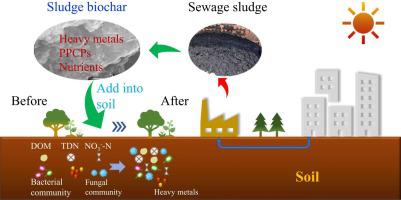Journal of Hazardous Materials ( IF 12.2 ) Pub Date : 2022-09-24 , DOI: 10.1016/j.jhazmat.2022.130053 Qing Zhu 1 , Yafeng Liang 1 , Qi Zhang 1 , Zhiyuan Zhang 2 , Cuiping Wang 1 , Sheng Zhai 3 , Yanhua Li 4 , Hongwen Sun 1

|
Sewage sludge contains a large number of nutrients and dangerous substances, when sludge was processed into sludge hydrochar that was added to the soil, which not only solve the problem of sludge disposal, but also amend the soil and fix pollutants in the soil. However, it was lack of report on the effect of the sludge hydrochar on soil compositions and soil microorganism community structures until now. In the present study, the hydrothermal carbonization method is used to prepare hydrochar from sewage sludge at temperatures of 180 ℃ and 240 ℃ at durations of 6 h and 15 h in this paper. The effects of the prepared sludge hydrochar on soil-derived dissolved organic matter (DOM), the content of total dissolved nitrogen (TDN) and NO3--N in soil, and the community structure of soil bacteria and fungi were evaluated. Furthermore, the change rules in heavy metal speciation in soils treated with sludge hydrochar were investigated. With the increase in the preparation temperature and dosage of sludge hydrochar, the main components of DOM changed from soluble microbial byproducts to fulvic acid-like and humic acid-like fractions through UV and fluorescence characterization. The sludge hydrochar prepared at low temperature could significantly increase the contents of TDN and NO3--N in the soil. Affected by sludge hydrochar, the dominant phylum of the bacterial community changed from Proteobacteria to Actinobacteria, and the dominant phylum in the fungal community did not change, but its relative abundance increased. Finally, the sludge hydrochar obtained when the carbonization time was 15 h was more beneficial to reduce the total amount and available content of heavy metals in the soil. The study provides a basis for sludge hydrochar application for the soil amendment.
中文翻译:

污水污泥水解产生的生物炭影响土壤性质和土壤中分布的重金属
污水污泥中含有大量的营养物质和危险物质,将污泥处理成污泥水炭后添加到土壤中,既解决了污泥的处置问题,又可以改良土壤,固定土壤中的污染物。然而,迄今为止,关于污泥水炭对土壤成分和土壤微生物群落结构影响的报道还很缺乏。在本研究中,本文采用水热碳化法从污水污泥中制备水炭,温度分别为 180 ℃ 和 240 ℃,持续时间分别为 6 小时和 15 小时。制备的污泥水炭对土壤来源溶解性有机质(DOM)、总溶解氮(TDN)和NO 3 -含量的影响-N 在土壤中,以及土壤细菌和真菌的群落结构进行了评估。此外,研究了污泥水炭处理土壤中重金属形态的变化规律。随着污泥水炭制备温度和用量的增加,通过紫外和荧光表征,DOM 的主要成分从可溶性微生物副产物变为类黄腐酸和类腐殖酸组分。低温制备的污泥水炭可显着提高土壤中TDN和NO 3 - -N的含量。受污泥水炭的影响,细菌群落的优势门从变形菌门变为放线菌门,真菌群落中的优势门没有变化,但其相对丰度增加了。最后,炭化时间为15 h时得到的污泥水炭更有利于降低土壤中重金属的总量和有效含量。该研究为污泥水化炭应用于土壤改良提供了依据。











































 京公网安备 11010802027423号
京公网安备 11010802027423号